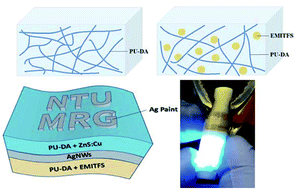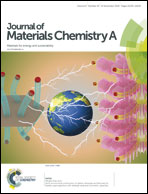A rapid low temperature self-healable polymeric composite for flexible electronic devices†
Abstract
The ability to undergo healing upon mechanical damage is a highly sought-after property for the new generation of flexible, integrable devices. The thermally reversible Diels–Alder (DA) mechanism for self-healing is promising but has been demonstrated for healing only at high temperatures (∼120 °C). However, the DA mechanism can be triggered at temperatures as low as 50 °C, indicating that the self-healing mechanism is limited by the thermal mobility of the polymeric chains. Herein, we show that incorporation of the ionic liquid 1-ethyl-3-methylimidazolium trifluoromethanesulfonate (EMITFS) alleviates this challenge, rapidly accelerating healing, while concomitantly improving the dielectric constant and the mechanical properties of a polyurethane derivative based on the DA chemistry (PU-DA). For optimized compositions, the healing temperature reduced from 120 °C to 60 °C and the maximum strain to failure significantly increased from 17.1% to 102.1%. Owing to the ionic polarizability of EMITFS, the composite exhibited highly attractive dielectric properties with the dielectric constant being enhanced from 2.7 to 12.9. Finally, we demonstrate a highly flexible, healable and fully solution-processed electroluminescent device.



 Please wait while we load your content...
Please wait while we load your content...